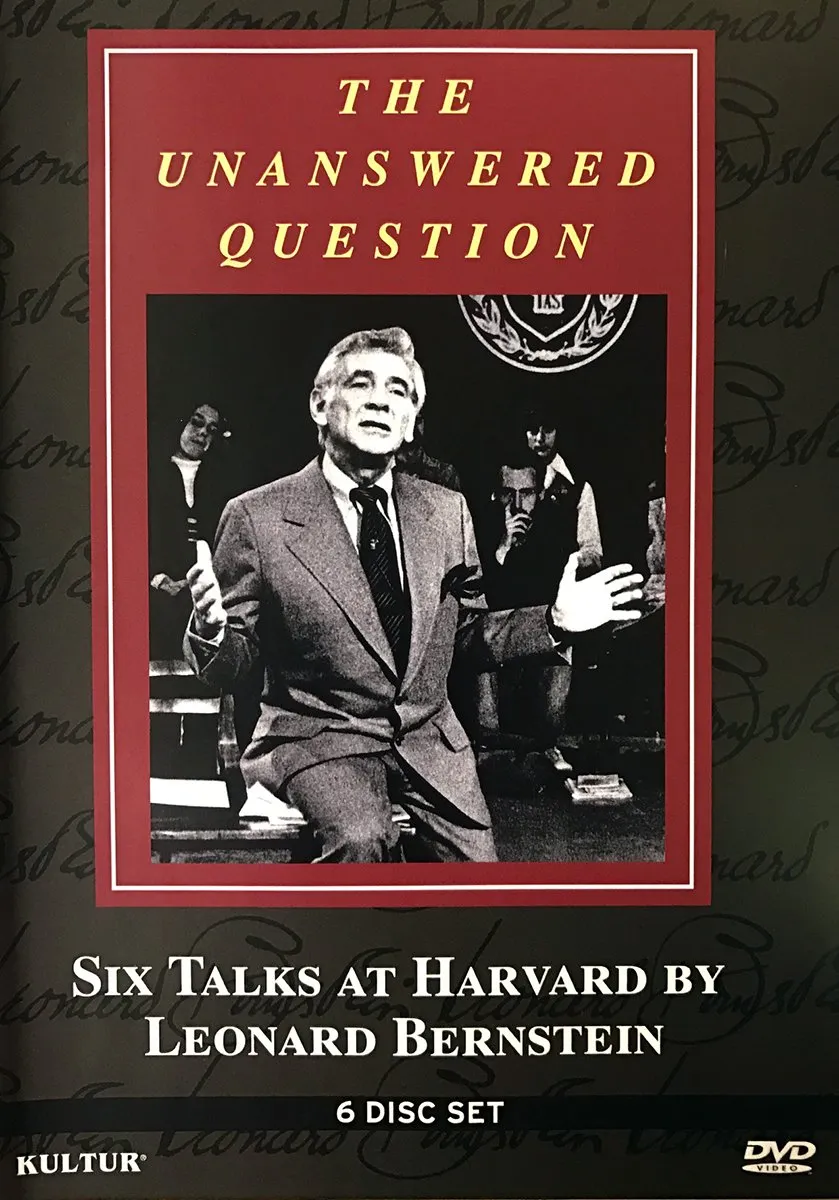Product description
This amazing 6 volume DVD explores all types of music, including: folk music, pop songs, symphonies, tonal and atonal works; all taught by legendary master composer and conductor, Leonard Bernstein.
Amazon.com
Always absorbing and frequently brilliant, Leonard Bernstein's The Unanswered Question is a very lucid and convincing discussion of music's history and forms, with particular emphasis on modern music. It addresses the average intelligent listener who is not musically trained but wants to know what makes music work--what is meant, for example, by "tonal" and "atonal." It requires some concentration, but Bernstein, a superb teacher, keeps technical jargon to a minimum, illustrates what he means with musical examples and graphics, and repeats key points.
Delivered in 1973, the talks were transcribed for a book, but in it Bernstein insists "The pages that follow were written not to be read, but listened to," really an endorsement of the video edition. The talks are, in fact, performances. Television was always kind to Bernstein; he had magnetism and knew how to use it. To illustrate various points in his analyses, he plays the piano frequently, sings occasionally, and conducts significant works of key composers: Mozart, Beethoven, Berlioz, Wagner, Ravel, Debussy, Ives, Mahler, and Stravinsky.
Bernstein traces the development of music from its origins to the 20th-century struggle between tonality (championed notably by Stravinsky) and atonalism (represented mainly by Schoenberg). The last two talks, devoted to these composers, are particularly enlightening, but all six are outstanding. He argues persuasively that humans are born with an ability to grasp musical forms, and that rules of musical syntax are rooted in nature--in mathematically measurable relations between tones and overtones.
These talks are a key document. They coincide chronologically, as cause and/or symptom, with the movement of America's leading composers back from Schoenbergian forms toward a tonal orientation. Bernstein predicts and promotes this movement, which is still in progress. He is clearly an advocate of tonality, but he discusses atonal music with sympathy and understanding. --Joe McLellan
From the Back Cover
Leonard Bernstein examines music from every age and place in the search for a worldwide, innate musical grammar. Folk music, pop songs, symphonies, tonal, atonal, well-tempered and ill-tempered works find a place in these discussions. All of them, Mr. Bernstein suggests, are grounded in a universal musical language. Using analogies between music and linguistics, Mr. Bernstein shows how this language can be understood as an aesthetic surface. Drawing on his insights as a master composer and conductor, he also explores what music means below the surface. Finally, Mr. Bernstein analyzes the crisis of twentieth-century music, finding its roots in all that has gone before. Written and delivered in 1973 when Leonard Bernstein was Charles Eliot Norton Professor of Poetry at Harvard University, with performances by Mr. Bernstein, the Boston Symphony Orchestra, and the Vienna Philharmonic. 780 minutes.
Musical Phonology: Explores the origins and development of music and language, with a performance of Mozart's Symphony No. 40 in G minor, K. 550. 104 minutes.
Musical Syntax: Compares the structures of music and speech, and discusses the multiple transformations of which both are capable, with examples from Mozart's Symphony No. 40 in G minor, K. 550. 95 minutes.
Musical Semantics: Demonstrates layers of meaning in Beethoven's Symphony No. 6 in F Major, Op. 68. 142 minutes.
The Delights and Dangers of Ambiguity: Explorations of new tonal fields by composers of the Romantic era. Musical illustrations include: Berlioz's "Romeo Alone" and "The Ball at the Capulets" from Romeo & Juliet, Wagner's "Prelude und Liebestod" from Tristan & Isolde, and Debussy's Prelude a l'apres-midi d'un faune. 142 minutes.
The Twentieth Century Crisis: Arnold Schoenberg's movement toward atonality and Gustav Mahler's anticipation of the crisis in twentieth-century music. Includes performances of Ives's The Unanswered Question, Ravel's "Feris" from Rapsodie Espagnole, and Mahler's Symphony No. 9 in D major, mvmt 4. 133 minutes.
The Poetry of Earth: Examines how Igor Stravinsky kept tonality viable while experimenting freely with dissonance. Includes a complete performance of Stravinsky's Oedipus Rex. 177 minutes.
- Aspect Ratio : 1.33:1
- Is Discontinued By Manufacturer : No
- MPAA rating : Unrated (Not Rated)
- Product Dimensions : 7.5 x 5.38 x 2 inches; 1.05 Pounds
- Director : Douglas Smith
- Media Format : Multiple Formats, Box set, Color, NTSC
- Run time : 13 hours and 13 minutes
- Release date : November 20, 2001
- Actors : Leonard Bernstein
- Language : English (Dolby Digital 2.0 Stereo)
- Studio : Kultur Video
- Number of discs : 1











